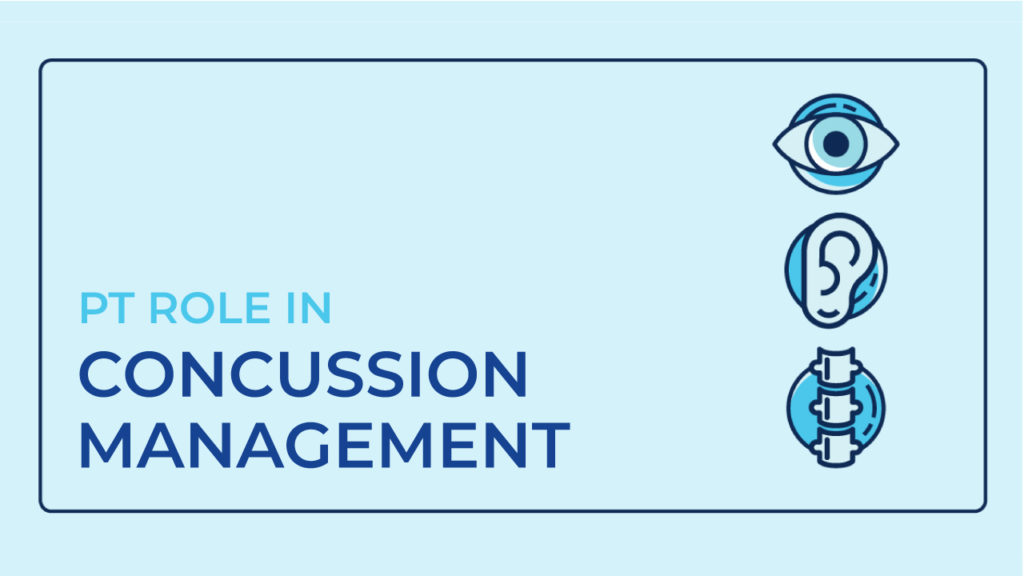Physical Therapist’s Role in Concussion Management
Benefits of Physical Therapy for Concussion Care
- Individualized treatment - Physical therapists work on multidisciplinary teams to offer comprehensive concussion care specific to each patients’ needs.
- Guided recovery - Physical therapists help patients manage their symptoms while teaching them proven at-home rehab exercises to help with their concussion recovery.
- Returning to normal activity or sport - Patients who work with physical therapists experience a safe and gradual return to life without overloading the brain and nervous system.

Physical therapists are important members of any concussion care team. They participate in active rehabilitation to help patients get better. Physical therapists are most commonly involved in vision, vestibular, and cervical spine rehabilitation.
Concussion Protocol for Physical Therapy
Before recovery begins, a patient must undergo a clinical interview to determine their treatment path forward. There are six clinical trajectories a patient may fall under including vestibular, ocular, cognitive fatigue, post-traumatic migraine, cervical, or mood. This step in the physical therapy concussion protocol allows clinicians to make treatment and recovery plans that meet each patient’s needs.
If a patient’s trajectory is vestibular, ocular, or cervical, they receive a physical therapy referral. Patients who fall under these categories may report headaches, dizziness, neck pain, fatigue, balance disturbances, oculomotor changes, or decreased coordination.
Vision Therapy for Concussions
1/3 of patients dealing with concussions experience visual problems including double or blurred vision, dizziness, and issues following a moving target. Axonal injury or blunt trauma to the visual control systems cause these symptoms. Physical therapists can detect visual problems by conducting the Vestibular-Ocular Motor Screening (VOMS) and use these top 10 vision therapy techniques for concussions:
- Pencil Push-Ups
- Pointer and Straw
- Brock String
- 3 Dot Card
- Life Saver Card
- HART Chart
- Marsden Ball
- Rotator Pegboard
- Michigan Tracking
- Thumb Pursuits and Saccades
Vestibular Rehabilitation After Concussion
At least half of all patients with concussion will experience balance or vestibular issues after a concussion. Patients affected in these areas may display decreased balance, proprioception problems, vision changes, vertigo, or hearing changes. Physical therapists can use the Balance Error Scoring System (BESS) to identify postural stability and control issues and to measure a patient’s recovery.
During the BESS test patients perform the following stances on both firm and foam surfaces:
- Double leg stance
- Single leg stance
- Tandem stance
The goal is for scores to improve as patients begin their rehab program. Physical therapists should record any deviations on a BESS balance test score sheet to track recovery. Here is a list of errors to note:
- Moving hands off the iliac crests
- Opening the eyes
- Stepping, stumbling or falling
- Abduction or flexion of the hip beyond 30 degrees
- Lifting the forefoot or heel off the surface
- Remaining out of the testing position for more than five seconds
Cervical Spine Rehabilitation
Physical therapists are integral to identifying and rehabilitating cervical spine deficits after a concussion. Patients who report neck pain, headaches, dizziness, oculomotor issues, and postural dysfunctions may need cervical spine rehabilitation. By determining one of the three components of treatment—cervical mobility dysfunctions, neuromuscular control, or strengthening—physical therapists can tailor their approach to care and use some of these techniques:
- Upper quarter screen
- Postural assessment
- Neurological testing
- Ligamentous instability testing
- AROM
- Vertebrobasilar insufficiency testing
- Joint mobility assessment
Role of Physical Therapist for Return to Activity
Returning patients to work, school, or a sport is a gradual process. Physical therapists play an active role by monitoring their patients’ heart rate and symptoms as they take on more activity. If a patient is outside of the target heart rate recommendations or reports an increase in symptoms, it’s likely the activity is too aggravating. Physical therapists can make adjustments and suggest alternatives to progress the patient along at a safe pace.
Here is a return to activity strategy plan that provides general rehabilitation steps:
- Medical assessment
- Rest
- Symptom limited activity
- Light Exercise
- Sports-specific exercise
- Non-contact training
- Medical clearance
- Full contact practice (for athletes)
- Return to sport (for athletes)
Become a Concussion Care Leader
The role of the physical therapist in concussion management is evolving. With more research showing the positive effects of exercise after a concussion and active rehabilitation, physical therapy will only become more vital to a patient’s recovery. Sign up today for the ImPACT Trained Physical Therapist credential program to learn treatment standards and how to create a concussion protocol for your practice.
[Download PT Role in Concussion Care PDF]
Spread the Word
NEED TRAINING?
Join other physical therapists who have become concussion management leaders by earning their ImPACT Trained Physical Therapist (ITPT) credential.
